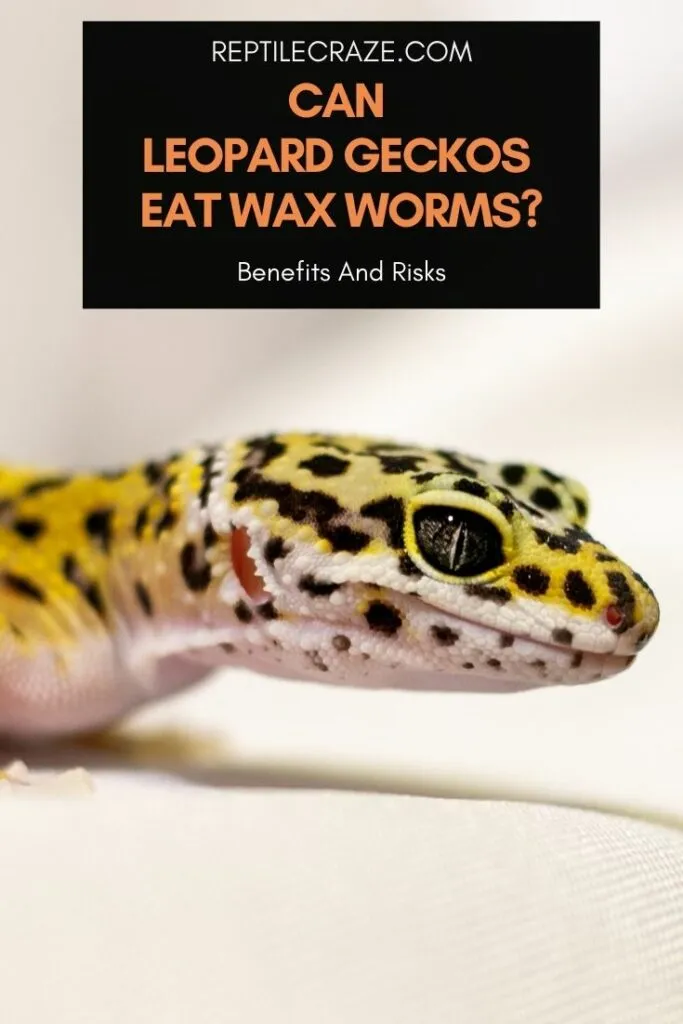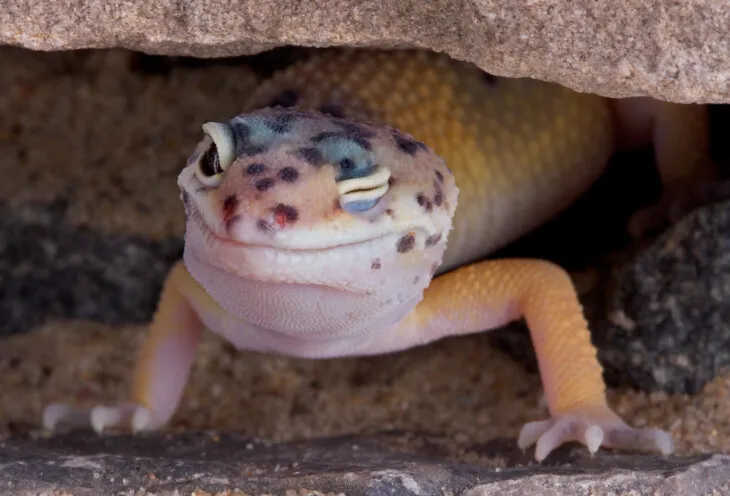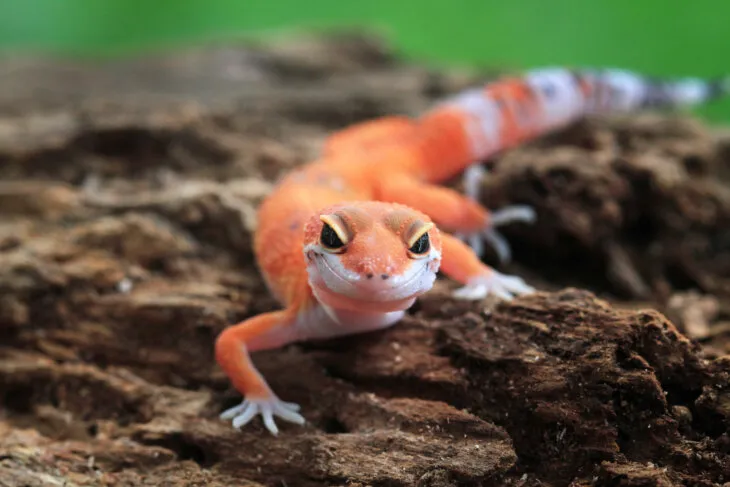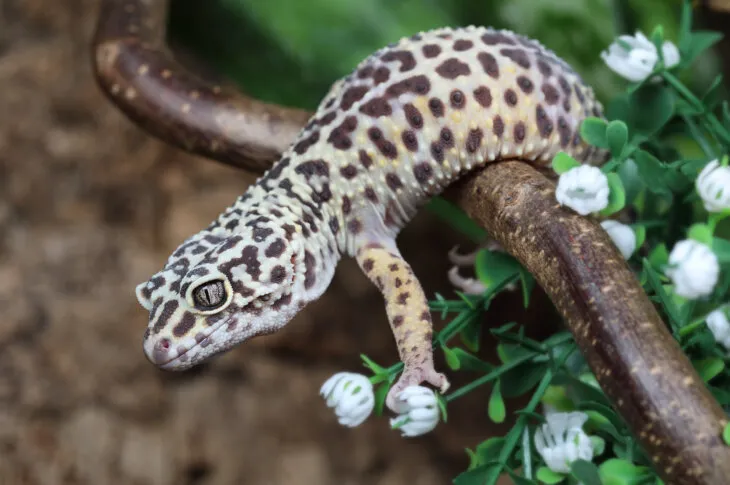
Wax worms (Galleria mellonella) are popularly sold as feeder insects for Leopard Geckos (Eublepharis macularius). But, are they good for your pet? Should you feed wax worms to your Leopard Gecko?
Leopard Geckos can eat wax worms. Wax worms are not toxic to Leopard Geckos but they have a poor nutritional profile and can contribute to obesity, MBD, and Hepatic Lipidosis. Wax worms can help increase the weight of a Leopard Gecko and can be used as treats or to stimulate appetite.
So, that’s the short answer, but there’s much more to learn about whether Leopard Geckos can eat wax worms. Read on to discover if baby Leopard Geckos should eat wax worms, and if you can feed dead wax worms to your pet.
Table of Contents
Leopard Geckos Can Eat Wax Worms
Leopard Geckos are perfectly safe to feed your Leopard Gecko. They are not toxic or damaging. However, they are not recommended as a staple foodstuff for Leopard Geckos due to their poor nutritional value.
Why Wax Worms Are Bad For Leopard Geckos
There are plenty of Leopard Gecko owners who swear that wax worms are not a suitable foodstuff. Let’s look in detail at why you may not want to feed wax worms to your Leopard Gecko.
1. Improper Nutrition
The nutritional value of wax worms is not beneficial to your Leopard Gecko. Wax worms are high in fat. Fats are incredibly energy efficient and contain more than twice the amount of calories per gram than carbohydrates or protein.
Other staple feeder insects such as crickets, mealworms, and dubia roaches tend to have better nutritional profiles for your Leopard Gecko. They provide more protein, with fewer calories.
Wax worms also have a strongly inverse calcium to phosphorus ratio. The ideal calcium to phosphorus ratio is 2:1. An inverse Ca:P ratio is not exclusive to wax worms. Many feeder insects have poor Ca:P ratios.
Nutritional Values Of Wax Worms vs. Staple Feeder Insects
| Wax Worms | Mealworms | Crickets | Dubia Roaches | |
| Moisture | 62% | 66% | 73% | 65% |
| Protein | 14% | 18% | 18% | 21% |
| Fat | 18% | 10% | 6% | 9% |
| Fiber | 3% | 2% | 2% | 1% |
| Ca:P Ratio | 1:7 | 1:7 | 1:9 | 1:3 |
The nutritional information available for feeder insects is not exact and varies across suppliers, books, websites, and journal articles. So, it is difficult to provide perfect nutritional information.
But, these figures are based on scientific research and give a good representation of approximate nutritional values. They clearly show that wax worms are comparatively low in protein and moisture but very high in fat.
2. Obesity
The high caloric value of wax worms makes them easy to overfeed. If your Leopard Gecko consistently eats too many calories, they will become overweight, and eventually obese.
If you notice signs of obesity you need to control their calories more carefully. Signs of obesity include fat bubbles in the armpits, belly fat rolls, or a slow waddling walk.
Obesity causes many physiological issues and illnesses. When a Leopard Gecko is obese, fat will begin to fill the subcutaneous space (beneath the skin) as well as the coelomic cavity (the abdomen). Eventually, fat will penetrate the organs, including the liver.
3. Fatty Liver Disorder
Fatty Liver Disorder, also known as Hepatic Lipidosis, results from overfeeding and obesity. Once the fat has penetrated the liver, it can cause a breakdown of liver function.
Wax worms are very high in fat. They are also easy to overfeed because they are both highly palatable (delicious) and high in calories.
The symptoms of Fatty Liver Disorder include loss of appetite, sudden weight loss, and eventually death.

4. Metabolic Bone Disease
Metabolic Bone Disease, also called MBD, is another common illness. MBD occurs when your Leopard Gecko gets too much phosphorus and not enough calcium and vitamin D. This can happen for several reasons, including lack of vitamin D or poor availability of UVB light.
However, feeding your Leopard Gecko a diet with an inverse calcium to phosphorus ratio is a major cause of MBD. Wax worms have an inverse calcium to phosphorus ratio. This means that they contain more phosphorus than they do calcium.
If your Leopard Gecko does not eat a calcium to phosphorus ratio of 2:1, there will not be enough bioavailable calcium in his bloodstream. Calcium is needed for organ function, for growth, and for females to make eggs.
To obtain the required amount of bioavailable calcium, the Leopard Gecko’s body will draw calcium from his bones. This causes his skeleton to become weakened and deformed. Eventually, MBD leads to death if left untreated.
MBD is easily preventable. It is also easy to halt its progression. But, the damage caused by MBD to the body of your Leopard Gecko cannot be reversed.
To improve the calcium to phosphorus ratio of wax worms and prevent MBD, it is important to dust them with calcium powder before feeding. We like to use this popular calcium supplement for that.
You can also gut load wax worms if you would like, but it isn’t really necessary. If you would like to know the perfect way to feed your leopard gecko wax worms, read our article here.
5. Addiction
Some owners are wary of feeding their Leopard Geckos with wax worms in case they get addicted. Wax worms don’t contain any truly addictive substances, so they aren’t going to become medically dependent upon them.
But, Leopard Geckos certainly can start refusing healthier, staple feeder insects and holding out for their favorite wax worms.
They can get behaviorally addicted to them. This will cause them to prefer wax worms, even when their health begins to suffer. This could also cause them to overeat when they wouldn’t usually.
Find out more about the fascinating question of how Leopard Geckos can get addicted to wax worms by reading our article.
6. Impaction
Wax worms are fairly low-risk for causing impaction, but it is possible. Impaction is caused when a lump of
The blockage prevents
Wax worms’ outer shell is made of chitin. This is also true for mealworms and superworms. Too much chitin can be hard to pass, as it is an indigestible dietary fiber.
However, the shell of younger wax worms is usually soft and flexible and not known to be at high risk for becoming trapped in the digestive system.
But, there are some environmental factors that can increase wax worms’ potential for causing impaction. Read about it in more detail in our article on how many wax worms to feed your Leopard Gecko.

Why Wax Worms Are Good For Leopard Geckos
So, if there are so many risk factors related to feeding wax worms to Leopard Geckos, why do we do it? Well, there are also many positive things about feeding wax worms to your Leopard Gecko.
Plus, the truth is that most of the risk factors can be mitigated by feeding the proper amount and preparing it correctly. We discuss this in detail in the articles linked above.
1. Stimulating Appetite
Wax worms are delicious to Leopard Geckos. This is because they are very palatable, thanks to their high fat content. High-fat foods cause dopamine to be released in the brain, which literally rewards your Leopard Gecko for eating.
Because of this, wax worms are great for stimulating appetites. If you have a sick Leopard Gecko that isn’t eating, or a young Leopard Gecko that just will not find his appetite, you can give wax worms a go.
Try slicing open the abdomen of a juicy wax worm and offer it to your picky Leopard Gecko. Once you have got them eating well, you can swap in some more nutritious foods.
2. Putting On Weight
If your Leopard Gecko is underweight, regrowing his tail, or recovering from illness, wax worms are a great way of piling on the pounds. But remember, they need more than just calories to stay healthy.
Ensure you dust your wax worms with calcium and multivitamin powder to increase their nutritional value. Also, increase all the elements of their diet, not just wax worms.
3. High-Value Rewards
Wax worms also make great rewards for use in training, thanks to their high-value to Leopard Geckos. Feeding as treats, not as part of the staple diet, is an ideal way to make the most of wax worms.
If you unexpectedly offer a wax worm as a reward after a successful handling session, your Leopard Gecko is more likely to repeat the good behavior in the future.
Can Leopard Geckos Eat Dead Wax Worms?
No. It is a very bad idea to feed dead wax worms to your Leopard Gecko.
Dead wax worms could have been suffering from any number of unknown illnesses before they died. Whatsmore, bacteria, and fungi would have begun decomposing the body since the moment of death.
If you feed a dead wax worm to your Leopard Gecko, it will also be eating the bacteria, fungi, and unknown diseases that could have caused the wax worm to die.
You can recognize dead wax worms by the fact that they will be dried out and darker in color. They also won’t be moving and wriggling, even if you place them on the warm palm of your hand for a few moments.
You should check the wax worm habitat often and remove any dead ones that you see. Disinfect your hands and any tools before then picking up a fresh worm and offering it to your Leopard Gecko.
Can Leopard Geckos Eat Damaged Wax Worms?
No. As with dead wax worms, injured or damaged wax worms could harbor any number of possible microbes or infections.
Before feeding any wax worm to your Leopard Gecko, you should inspect it thoroughly. Any injuries, skin complaints, strange fluids, marks, or discolorations mean that this is not a suitable wax worm to feed to your Leopard Gecko.
Just as with the dead wax worms, you should remove any damaged individuals from the habitat and dispose of them. Wash your hands and tools afterward.
Can Leopard Geckos Eat Wax Worm Pupae?

Yes. Leopard Geckos can eat wax worm pupae.
Wax worms aren’t really worms, they are the larval stage of the honeycomb moth, also known as the wax moth (Galleria mellonella). In order to change from larvae to moths, the wax worms spin cocoons and become pupae.
Leopard Geckos can eat wax worm pupae. But, it is riskier. Their cocoons could increase their risk of causing impaction. Also, it is much more difficult to identify whether the pupa is alive and healthy.
So, you run the risk of feeding a sick or dead pupa to your Leopard Gecko.
Can Leopard Geckos Eat Wax Moths?
Yes. Wax moths are safe for Leopard Geckos to eat. Leopard Geckos are excellent insect hunters. If you can, let them hunt the flying moths around their
But, it is much more difficult to judge the right size of moth for the Leopard Gecko. Play on the safe side and choose a smaller moth for your Leopard Gecko to avoid choking and impaction.
Learn more about that in our article: Can leopard geckos eat wax moths?
Can Leopard Geckos Eat Black Wax Worms?
Maybe. This answer is a little less clear-cut. Wax worms can sometimes darken as they turn into pupae. They can also darken as they die.
It is OK to feed worms that are about to pupate to Leopard Geckos. They do not become toxic or completely indigestible. But, they are larger and harder than younger wax worms, so they are not suitable for smaller Leopard Geckos as they could cause compaction.
As we discovered above, it is not safe to feed dying or dead wax worms to Leopard Geckos. They can carry bacteria or diseases.
If you do choose to feed darker-colored wax worms to your Leopard Gecko there may be some confusion over what is a pupating wax worm and what is a dying wax worm. For this reason, we do not recommend feeding black wax worms to your Leopard Gecko.
How Many Wax Worms Can Leopard Geckos Eat?
Wax worms should only be fed as a sporadic treat and are not suitable as a staple part of your Leopard Gecko’s diet. Find out exactly how many wax worms Leopard Geckos can eat in our in-depth guide.
Where Should You Buy Wax Worms From?
Wax worms have a very widespread distribution and can be found naturally worldwide. However, in Australia, they are an invasive species.
Wax moths, or honeycomb moths as they are otherwise known, parasitize bees. So, wax worms are always found near beehives.
There are many providers of live feeder insects nowadays. Many of them operate by courier and mail, rather than relying on foot-traffic customers.
As a result, it is a lot easier to get hold of wax worms than it might have been in the past.
Despite the wide choice, it is still a good idea to shop from a breeder that is as close to you as possible and has a fantastic reputation.
Choosing a breeder close to you will reduce the transit time of your wax worms. It may also reduce the chance that they are exposed to damaging conditions such as extreme temperatures or being shaken about.
A wax worm breeder and supplier with a great reputation is worth paying more for. The methods that they use to house, feed, and transport the wax worms will have a direct effect on the health of your Leopard Gecko.
So, it isn’t possible for us to give a silver-bullet recommendation for the best place to buy your wax worms, as the answer will be different for everyone. But here are some well-reputed suppliers in the USA to get you started.
Josh’s Frogs wax worms have glowing reviews and offer a live arrival guarantee on all feeder insects. Reviewers were happy with the plumpness of the worms and how wriggly they were.
Josh’s Frogs ship their wax worms on Aspen wood bedding, not pine. Josh’s Frogs are based in Owosso, Michigan. They ship orders that are placed by 12.00 pm EST the same day.
Rainbow Mealworms specialize in mealworms but have excellent reviews for their wax worms too. Repeat customers say that their mealworms always arrive more alive and feisty than any previous retailers they have tried.
Rainbow Mealworms are based in Compton, California. They do have walk-in hours and you can collect online orders by scheduling a pick-up. Orders made before 12:00 pm PST are shipped the same day. There are many shipping options.
DubiaRoaches.com are based in Wichita, Kansas. They have hundreds of excellent reviews, that claim the wax worms always arrive fat and healthy.
DubiaRoaches.com offer next-day shipping. They also have an insurance add-on option to cover damaged or dead wax worms.

How Should You Store Wax Worms?
There are a few options when it comes to storing wax worms, but all are quite easy. The container that the wax worms arrive in is usually appropriate to keep them in.
Store the wax worms at low humidity. If the bedding in the container is at all damp, it needs to be aired out. If you wish to change it, remember not to use pine wood shavings. These are toxic to your Leopard Gecko.
You can store your wax worms in the refrigerator at 55-60 degrees Fahrenheit. The back of the fridge will be too cold, but the fridge door will likely be the right temperature. This will prolong their larval stage.
At this low temperature, they will go dormant and stop eating. But, they also won’t move much. Try to let them warm up to room temperature before feeding.
You can also store your wax worms at room temperature. At room temperature, they will pupate much more quickly. They will also be more lively.
Be aware that they could turn into moths unexpectedly, so keep a secure lid on the container so that they don’t fly away.
Check the container daily. Remove any black or dead wax worms. Remove the silk from any worms that are spinning cocoons if you want to prevent them from pupating.
There is no need to feed the wax worms unless you wish to gut load them.
What Age Can Leopard Geckos Eat Wax Worms?
Leopard Geckos can eat wax worms at any age. However, we don’t recommend that you feed wax worms to hatchling and young juvenile Leopard Geckos.
Growing Leopard Geckos have a greater requirement for protein and calcium than adult Leopard Geckos. Feeding wax worms is not ideal. You should feed high-protein foods like crickets and dubia roaches.
Also, young Leopard Geckos are just beginning to taste a range of insects and establish their staple diet. It is best not to introduce wax worms at this stage. The young Leopard Gecko may then refuse less tasty items.
But, if you absolutely cannot get your young Leopard Gecko to begin eating staple feeder insects, you could use a trick with wax worms to stimulate their appetite. Find out how in our article about why your Leopard Gecko won’t eat wax worms.
A good rule of thumb is to only introduce wax worms and other treats after your Leopard Gecko is fully grown and has established a baseline healthy diet. Leopard Geckos reach their full size from around 18 months.
Should Leopard Geckos Eat Wax Worms?
Here at Reptile Craze, we do like to feed our Leopard Geckos wax worms. If you select and prepare your wax worms properly, and only give them in moderation, your Leopard Gecko is unlikely to become addicted or suffer from poor nutrition.
Giving wax worms as treats is enjoyable for both us and our Leopard Geckos. Wax worms have been a valuable reward when training positive relationships and desirable behavior.
Still, if you are looking for better worms to feed a leopard gecko, read this article.
- Enchi Ball Python: A Unique and Stunning Morph of Python regius - March 27, 2025
- Emerald Tree Monitor: The Enigmatic Green Guardian of the Rainforest - March 26, 2025
- The Egyptian Cobra (Naja haje): A Fascinating Serpent - March 25, 2025
